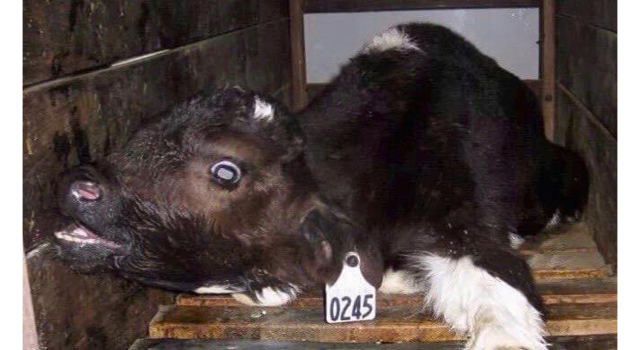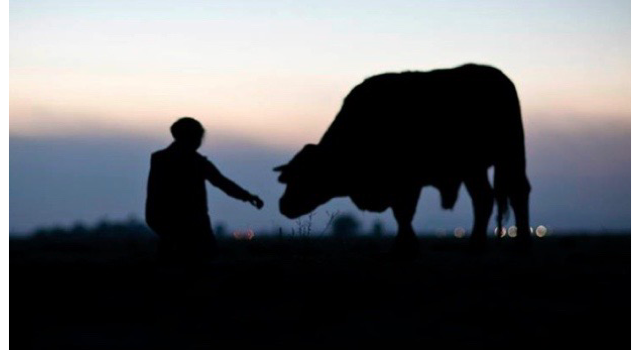Animals In Zoos Are Dying From Bird Flu. Dozens of rare animals including tigers, lions…

Fur Farming Not Only Causes Suffering To Animals.
We Animals Media has documented horrific conditions and intense suffering for animals trapped inside two Quebec fur farms.
Images taken in August 2022 show foxes living in small barren wire cages and minks confined in filthy, crowded conditions.
In 2022, an estimated 60 mink farms remain in Canada, mostly in the eastern provinces, and approximately 35 fox farms remain in six of the country’s provinces.
Canada still produces over one million minks and around 5,000 foxes each year.
The number of fox and mink farms in the province of Quebec are dwindling, with farms visibly downsizing in space and numbers.
This decline of the industry in Quebec reflects national and global trends.
There were over 300 fur farms in Canada in 2011, but fewer than 100 fur farms in 2021.
Farmed minks are kept in small cages.
They can turn around but cannot always stand up to stretch.
Pregnant minks are kept in cages with a wooden nesting box.
When they give birth, the conditions become cramped as the animals grow quickly.
As minks are naturally solitary animals, the stress of unnaturally close confinement causes them to fight, injure and sometimes cannibalise one another.
Those who survive these conditions are killed by gassing and then skinned for use in the fashion industry for coats, trim and trinkets.
Semi-aquatic animals who are highly physiologically evolved, minks are prone to hypoxia and can suffer significantly during gassing.
As standard industry practice, farmed foxes are kept in small cages from birth until the time they are killed by anal electrocution, which the fur industry states takes up to 10 seconds.
Foxes can turn around in their cages and sometimes have a small nesting box.
Some of the cages are in long sheds, while others are exposed to the elements 365 days a year in an open-sided cage with a roof.
Most cages have only wire mesh for a floor.
Farmed foxes live in confinement, alone or with another fox, until they are killed for use in the fashion industry.
Fur farming not only causes suffering to animals.
Run-off from these farms can cause blue-green algae to bloom in nearby waterways, polluting them irreparably and sickening other wildlife and humans.
( We Animals Media, 15.09.2022 ) Source: medium.com
The UK Has More Than 1,000 US-Style Mega Factory Farms.
New research has revealed that there are more than 1,000 US-style mega-farms in England, Wales and Northern Ireland.
Mega-farms are defined as those that hold more than 125,000 birds reared for meat, or 82,000 egg-laying hens, 2,500 pigs, 700 dairy cows or 1,000 beef cattle.
In the US they are officially called Concentrated Animal Feeding Operations (CAFO).
By 2021, the number of farms in the UK that met the US definition of a CAFO was at least 1,099, according to the research.
From 2016 to 2020, the number of mega-farms in England increased from 818 to 944.
Of these, 745 kept chickens and hens and 199 kept pigs.
There are four chicken farms in the UK registered for one million birds, with the largest holding up to 1.4 million.
The biggest three pig farms hold more than 20,000 sows and boars.
Regarding dairy farming, there are at least 19 mega-farms.
The largest UK “zero-grazed” mega-dairy-farms is said to keep 2,000 animals.
US-style beef feedlots, where cattle are fattened up before slaughter, were first found in the UK in a 2018 Guardian investigation.
The UK kills one billion chickens, 10 million pigs and 2.6 million cattle a year, most kept in intensive units.
These are a leading cause of our climate crisis, are driving pollution and biodiversity loss, and are increasing the health risks associated with ammonia pollution.
Factory farming are the perfect environments for the development of new emerging zoonotic diseases.
( Jordi Casamitjana, 31.08.2022 ) Source: veganfta.com
Animal Activist In Ukraine Sentenced To 13 Years In Prison.
On September 29, 2022, Maxim Plokhoi, an animal and vegan activist in Ukraine, was sentenced to 13 years imprisonment.
Maxim was found guilty of taking 13 hostages on a bus in Ukraine in late 2020, releasing them unharmed when the country’s president recommended publicly that everyone watch the film “Earthlings”, which depicts the suffering of animals that are eaten routinely by humans.
Maxim said: “This movie (Earthlings) is about war. The most bloodthirsty, cruel and unfair war in the history of the Earth – the war of people against other animal species. A war of total, commonly accepted violence against the defenceless, unable to resist. This war is the root cause and ground of all wars between humans. It is the firing ground for our cruelty. I stood up for billions of living beings. One is not born a human, one becomes a human by the struggle for justice. Get up, become a human”.
Maxim Plokhoi’s words in court: “An act is considered right if its goal is to improve the lives of the largest number of not only people but all living beings on Earth. The purpose and motive of my action is the demand for justice. It was not a terrorist attack. It was a performance protest against the terrorism of people over Living Nature. It was a protest against the injustice of the system of power. What my hostages have endured cannot be compared to what billions of animals are going through every day, every minute, whom we are mercilessly torturing and waning. What 13 people have experienced cannot be compared with the injustice suffered by millions of people who are hostages of the system of power. I stood up for those who cannot, do not know how to protect themselves. Sleep of conscience, loss of consciousness are too strong to overcome this by legal means. The evil of violence against Living Nature is so accepted and normalised that it is impossible to effectively resist it with a peaceful protest. Force hears only force.”
When the sentence was announced, Maxim said: “Don’t put the truth in jail. Long live the Anti-System! Legal terrorists, have your prison soap to wash your life from blood and lies. Killing people begins with killing animals.”
( Animal Liberation Press Office, 02.10.2022 )
Source: animalliberationpressoffice.org
The Consumption Of Dog Meat Continues In Vietnam.
A joint investigation by Asia for Animals Coalition and We Animals Media has revealed brutal and illegal wet market conditions for animals in Vietnam, including dogs and cats, critically endangered wildlife, rats, birds, snakes and toads.
National and international media have extensively reported about dog meat consumption, and in 2018, the Vietnamese government declared that it would ban dog meat consumption by 2021.
Despite this, the dog killing process can still be seen in public spaces and with the right access also behind closed doors.
We Animals Media photojournalists, Aaron Gekoski and Napat Wesshasartar, investigated multiple markets in the cities of Hanoi and Ho Chi Minh where they documented caged dogs being killed and sold for meat to paying customers in Hanoi’s public markets.
Vendors typically kill the dogs by striking their heads with plywood, then stabbing them in their hearts.
After that, they will put their bodies into a fur-removing machine before burning their skins.
Many of these dogs are imported from Cambodia, Laos and Thailand.
While the dog meat trade is not illegal, consuming cats was banned in Vietnam in 1998, but this directive was later cancelled in 2020.
Vendors openly sell dead cats alongside cages of live cats.
The consumption of dog meat is more popular in the northern parts of Vietnam than the south.
Even now, it is considered a delicacy by some and yet still a staple by others.
Despite this, many Vietnamese are fighting to end the practice.
Most of the killing process is conducted in clear view of other living dogs, who are crammed together in groups of about 10 in cages no larger than two square metres.
Ten to twenty dogs and cats are usually killed and sold per day at a given market.
( We Animals Media, 25.08.2022 ) Source: weanimalsmedia.org
“From poor wildlife tourism venues and the bear bile industry, to the illegal wildlife and dog meat trades, Vietnam faces a host of animal welfare problems. Our investigation of these industries reveals the suffering of countless animals. These markets are also hotbeds for disease which need to be investigated by the authorities.”
( Aaron Gekoski, animal photo-journalist )
“I normally set aside my emotions and focus on the assignment, however, when I have to go through all of the footage that I shot, it’s heartbreaking. Seeing our companion animals being killed, hearing the sound of the injured dogs, and smelling their blood – it’s horrible and unacceptable. Historically, dog and cat consumption is normal, especially during famine or world war. But Vietnam has been far from that era for years.”
( Napat Wesshasartar, animal photo-journalist )
“I’ve seen dogs clubbed over the head and stabbed in the throat, rats smashed against the pavement and then cut up with scissors, turtles pulled apart alive, and some of the most inhumane treatment of animals imaginable. No matter how you try and rationalise it, the pain we inflict upon other living beings cannot be justified. No food or medicine is worth the immense suffering that precedes it.”
( Aaron Gekoski, animal photo-journalist in Vietnam )
Animal Abusers Whose Disrespect For Wildlife Is Total.
Quotes on the website homepage of the animal lovers otherwise known as The Devon & Somerset Staghounds (DSSH), paint themselves as part of some sort of welcoming committee to an area of England (given that it’s a ‘national park’) where animals might be allowed to live out their lives in relative safety.
Only of course, animals are not safe here (our ‘national parks’ are actually managed in large part for shooting and hunting) and the DSSH are not ‘animal lovers’.
They are, going on evidence collected by groups like the League Against Cruel Sports over many years, animal abusers whose disrespect for wildlife is total.
How else to explain the footage taken by the League on Exmoor which shows sickening scenes of animal cruelty with hunters chasing an exhausted stag, surrounding it and tormenting it, in a bid to either hold it down and shoot it or steer it to where it could be shot?
The League’s investigators also took photos and video showing two hunters using a whip to force the stag to continue running so they could enjoy prolonging the ‘chase’.
That’s the ‘culture’ and the ‘beauty’ of Exmoor – and of hunting – which these people are supposedly welcoming us to?
Unsurprisingly, nobody who loves wildlife wants any part of it.
( Charlie Moores, 07.10.2020 ) Source: waronwildlife.co.uk
Thousands Of Irish Racehorses Slaughtered For Human Consumption.
Thoroughbred foals produced for the horse racing industry are being slaughtered for human consumption when they are less than one year old.
They were among more than 3,000 racehorses killed in Irish meat factories since 2020, according to information from the Department of Agriculture, Food and the Marine.
The ages of thoroughbreds slaughtered in the past two-and-a-half years shows that 151 were just one year old, while another 288 were under three.
Four foals were slaughtered before reaching 12 months of age.
The average life expectancy of a racehorse is between 25 and 30 years.
The figures reveal that only 210 or 7% of the thoroughbreds slaughtered were aged over 20 years.
More than half (1,534) were under six when they arrived at the meat factory, and nearly one in three (839) was younger than four years old.
The statistics relate to thoroughbreds that had passports issued by horse racing conglomerate Weatherbys, and do not include thousands of other equines slaughtered for human consumption during the same period.
Animal Aid, a rights group campaigning against horse racing, claims the large number of thoroughbreds ending up in meat factories is linked to “huge and unregulated overproduction” of equines in Ireland and the UK.
Video footage obtained by Animal Aid featured in a BBC Panorama documentary last year (2021), which revealed that Irish racehorses were being transported to abattoirs in the UK for slaughter against animal welfare guidelines.
It also alleged that contaminated horse meat was entering the human food chain as a result of microchips being fraudulently swapped in animals that were earmarked for slaughter.
Most Irish horse carcasses are exported to continental Europe.
( Darragh McDonagh, 04.09.2022 ) .. thesun.ie



This Post Has 0 Comments